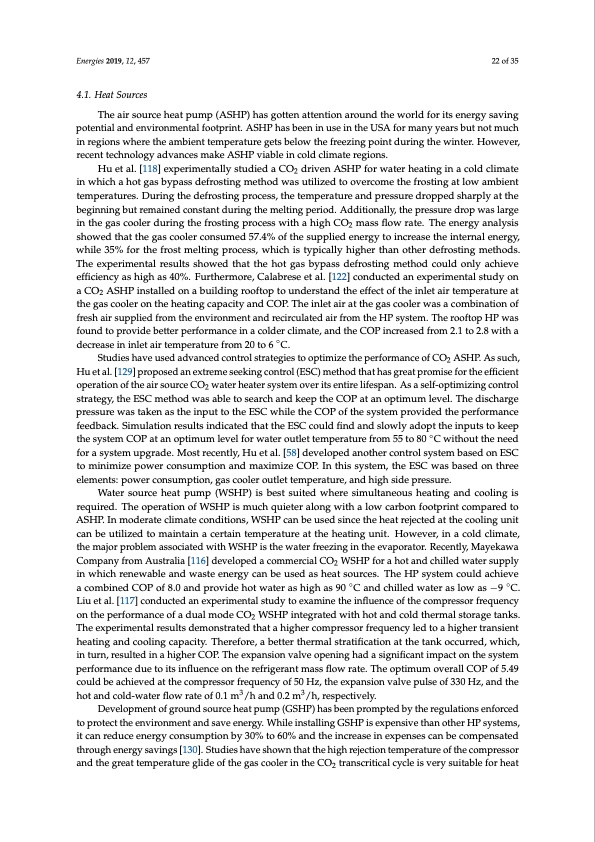
PDF Publication Title:
Text from PDF Page: 022
Energies 2019, 12, 457 22 of 35 4.1. Heat Sources The air source heat pump (ASHP) has gotten attention around the world for its energy saving potential and environmental footprint. ASHP has been in use in the USA for many years but not much in regions where the ambient temperature gets below the freezing point during the winter. However, recent technology advances make ASHP viable in cold climate regions. Hu et al. [118] experimentally studied a CO2 driven ASHP for water heating in a cold climate in which a hot gas bypass defrosting method was utilized to overcome the frosting at low ambient temperatures. During the defrosting process, the temperature and pressure dropped sharply at the beginning but remained constant during the melting period. Additionally, the pressure drop was large in the gas cooler during the frosting process with a high CO2 mass flow rate. The energy analysis showed that the gas cooler consumed 57.4% of the supplied energy to increase the internal energy, while 35% for the frost melting process, which is typically higher than other defrosting methods. The experimental results showed that the hot gas bypass defrosting method could only achieve efficiency as high as 40%. Furthermore, Calabrese et al. [122] conducted an experimental study on a CO2 ASHP installed on a building rooftop to understand the effect of the inlet air temperature at the gas cooler on the heating capacity and COP. The inlet air at the gas cooler was a combination of fresh air supplied from the environment and recirculated air from the HP system. The rooftop HP was found to provide better performance in a colder climate, and the COP increased from 2.1 to 2.8 with a decrease in inlet air temperature from 20 to 6 ◦C. Studies have used advanced control strategies to optimize the performance of CO2 ASHP. As such, Hu et al. [129] proposed an extreme seeking control (ESC) method that has great promise for the efficient operation of the air source CO2 water heater system over its entire lifespan. As a self-optimizing control strategy, the ESC method was able to search and keep the COP at an optimum level. The discharge pressure was taken as the input to the ESC while the COP of the system provided the performance feedback. Simulation results indicated that the ESC could find and slowly adopt the inputs to keep the system COP at an optimum level for water outlet temperature from 55 to 80 ◦C without the need for a system upgrade. Most recently, Hu et al. [58] developed another control system based on ESC to minimize power consumption and maximize COP. In this system, the ESC was based on three elements: power consumption, gas cooler outlet temperature, and high side pressure. Water source heat pump (WSHP) is best suited where simultaneous heating and cooling is required. The operation of WSHP is much quieter along with a low carbon footprint compared to ASHP. In moderate climate conditions, WSHP can be used since the heat rejected at the cooling unit can be utilized to maintain a certain temperature at the heating unit. However, in a cold climate, the major problem associated with WSHP is the water freezing in the evaporator. Recently, Mayekawa Company from Australia [116] developed a commercial CO2 WSHP for a hot and chilled water supply in which renewable and waste energy can be used as heat sources. The HP system could achieve a combined COP of 8.0 and provide hot water as high as 90 ◦C and chilled water as low as −9 ◦C. Liu et al. [117] conducted an experimental study to examine the influence of the compressor frequency on the performance of a dual mode CO2 WSHP integrated with hot and cold thermal storage tanks. The experimental results demonstrated that a higher compressor frequency led to a higher transient heating and cooling capacity. Therefore, a better thermal stratification at the tank occurred, which, in turn, resulted in a higher COP. The expansion valve opening had a significant impact on the system performance due to its influence on the refrigerant mass flow rate. The optimum overall COP of 5.49 could be achieved at the compressor frequency of 50 Hz, the expansion valve pulse of 330 Hz, and the hot and cold-water flow rate of 0.1 m3/h and 0.2 m3/h, respectively. Development of ground source heat pump (GSHP) has been prompted by the regulations enforced to protect the environment and save energy. While installing GSHP is expensive than other HP systems, it can reduce energy consumption by 30% to 60% and the increase in expenses can be compensated through energy savings [130]. Studies have shown that the high rejection temperature of the compressor and the great temperature glide of the gas cooler in the CO2 transcritical cycle is very suitable for heatPDF Image | Recent Advances in Transcritical CO2 (R744) Heat Pump System

PDF Search Title:
Recent Advances in Transcritical CO2 (R744) Heat Pump SystemOriginal File Name Searched:
energies-12-00457.pdfDIY PDF Search: Google It | Yahoo | Bing
CO2 Organic Rankine Cycle Experimenter Platform The supercritical CO2 phase change system is both a heat pump and organic rankine cycle which can be used for those purposes and as a supercritical extractor for advanced subcritical and supercritical extraction technology. Uses include producing nanoparticles, precious metal CO2 extraction, lithium battery recycling, and other applications... More Info
Heat Pumps CO2 ORC Heat Pump System Platform More Info
| CONTACT TEL: 608-238-6001 Email: greg@infinityturbine.com | RSS | AMP |